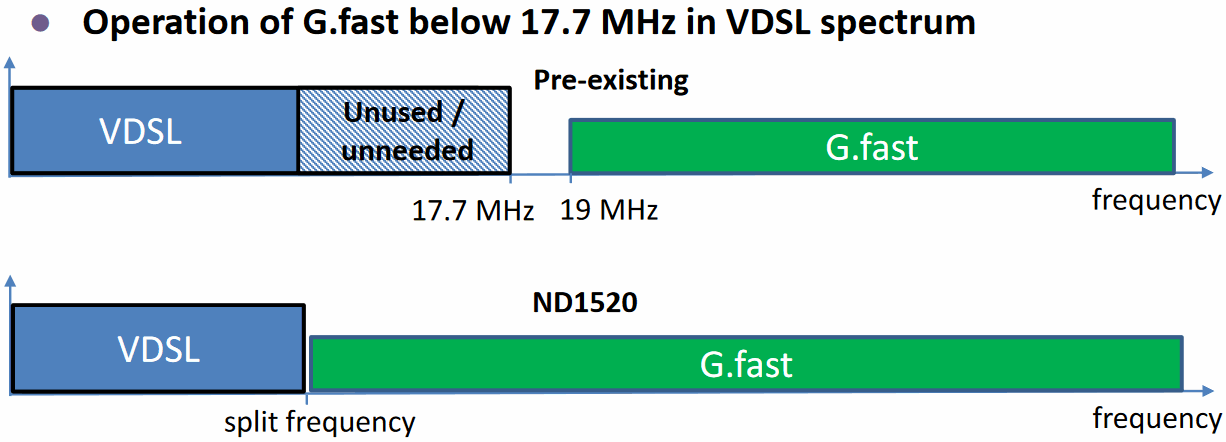Band Plan Change Boosts Speed on Some UK G.fast Broadband Lines UPDATE
A few customers with G.fast based hybrid fibre “ultrafast broadband” (100Mbps+) ISP lines have this week noticed a modest boost to their download speeds after a resync, which appears as if it could be associated to an interesting change with the operator’s spectrum frequency allocation (band plan) for the service.
The change, which was first spotted by a member of the Kitz community, occurred on a short (good quality) G.fast line where the maximum attainable downstream rate jumped from 347Mbps to 383Mbps (+36Mbps), although we should point out that G.fast is capped at 330Mbps (max usable) by Openreach (BT). Another G.fast user on a slower line reported a similar resync event, which saw their speed go from 229Mbps to 244Mbps (+15Mbps).
Interestingly a tentative analysis of this speed increase appeared to show a change in the band plan for G.fast. At present Openreach’s G.fast technology uses 19-106MHz of spectrum frequency, which gives them some separation from the slower 80Mbps capped VDSL2 based Fibre-to-the-Cabinet (FTTC) service that harnesses up to 17.664MHz. The separation helps to avoid interference between technologies.
Advertisement
However the analysis appears to show that on related lines Openreach may have reduced G.fast’s starting point from 19MHz to around 17.69MHz, which leaves only a tiny gap to VDSL2. The extra spectrum thus results in a small speed boost, which will of course vary depending upon the quality or length of copper cable from a local G.fast pod. We have asked the operator and are awaiting their feedback, so at the moment this is not confirmed.
Earlier this year we did issue an update on Openreach’s related spectrum refarming (sharing) developments, which form part of a wider project to find ways of getting G.fast and VDSL2 to co-exist in overlapping spectrum frequencies down to 2.2MHz as a minimum (here).

As part of that work it was noted that the easiest first step, albeit one with the least performance benefit, would be to narrow the gap between VDSL2 and G.fast spectrum. According to the study group’s data, the potential gain to G.fast would only be up to 10Mbps if all they chose to do was reduce the technology’s start point from 19MHz to nearly 17.7MHz (i.e. trying to avoid any overlap with VDSL).
Advertisement
We are expecting to see an update from this study group by the end of 2019 but by the looks of it Openreach may have already enacted the easiest change and thus given G.fast a boost. Doing this would be fairly painless as the earlier study showed that interference wasn’t much of a problem. We hope to have an official update soon, so take this all with a pinch of salt until we get something confirmed.
As a side note this change might help to mitigate, albeit only a little bit, the impact on coverage from Openreach’s recent decision to raise G.fast’s minimum selling speed from 100Mbps to 120Mbps (here).
We’d love to hear from any other G.fast users who have spotted the above change, although such things are usually deployed in a phased way and so may not yet be impacting all such lines.
UPDATE 23rd August 2019
Advertisement
Openreach has just confirmed the aforementioned band plan change. A spokesperson told ISPreview.co.uk, “Lowering the Gfast start frequency helps us slightly improve the performance of Gfast across the estate, and mainly on longer and slower lines, increasing speeds for those with the lowest speeds, and potentially reducing the number of No Sync / Sub 100 [Mbps] lines that we might get.”
The operator added that they are still in the “early stages of the rollout” at the moment and so it won’t be live for everybody.
Mark is a professional technology writer, IT consultant and computer engineer from Dorset (England), he also founded ISPreview in 1999 and enjoys analysing the latest telecoms and broadband developments. Find me on X (Twitter), Mastodon, Facebook, BlueSky, Threads.net and Linkedin.
« TalkTalk’s UK ISP FibreNation FTTH Rollout Partners Makehappen


















































Comments are closed